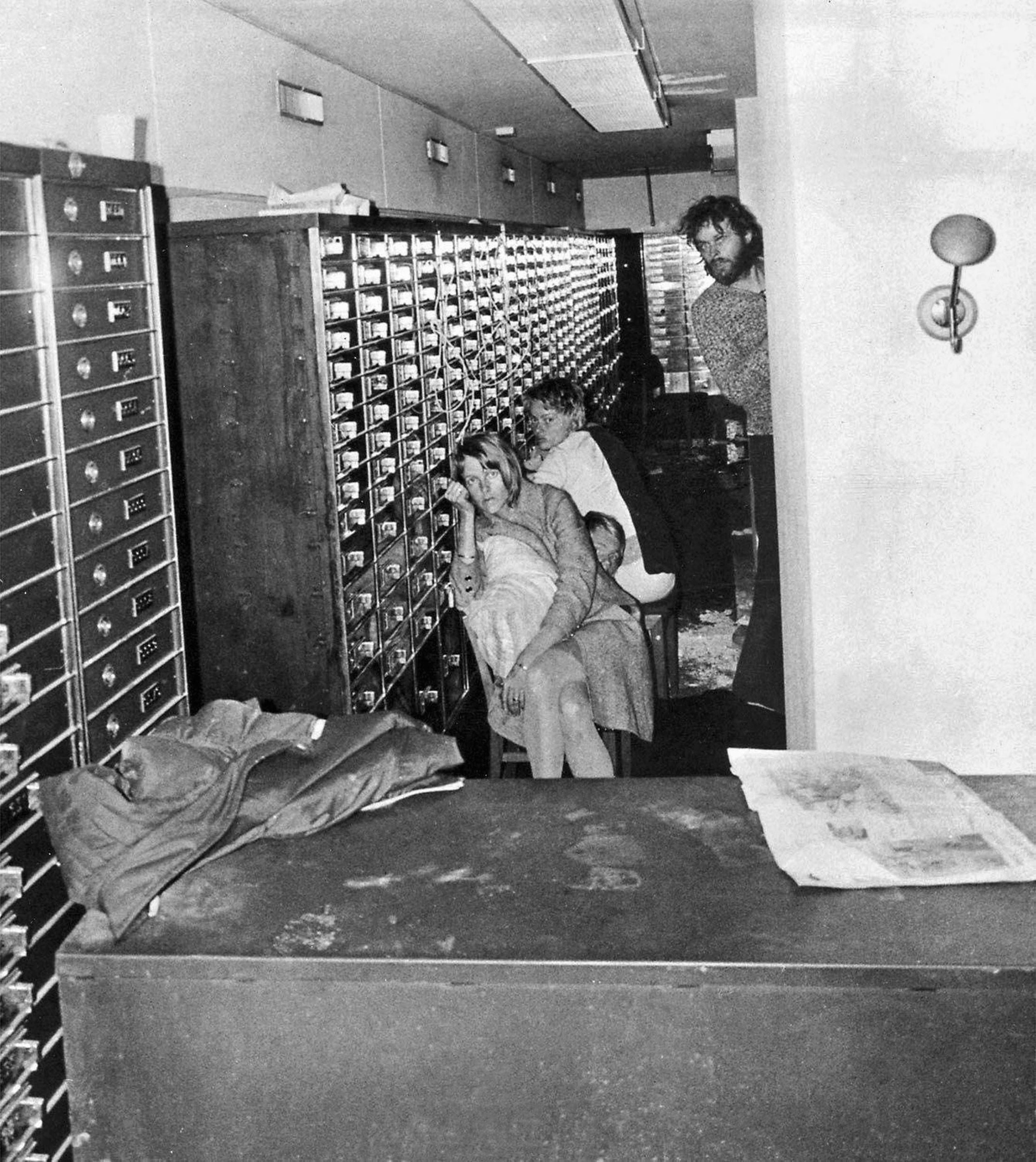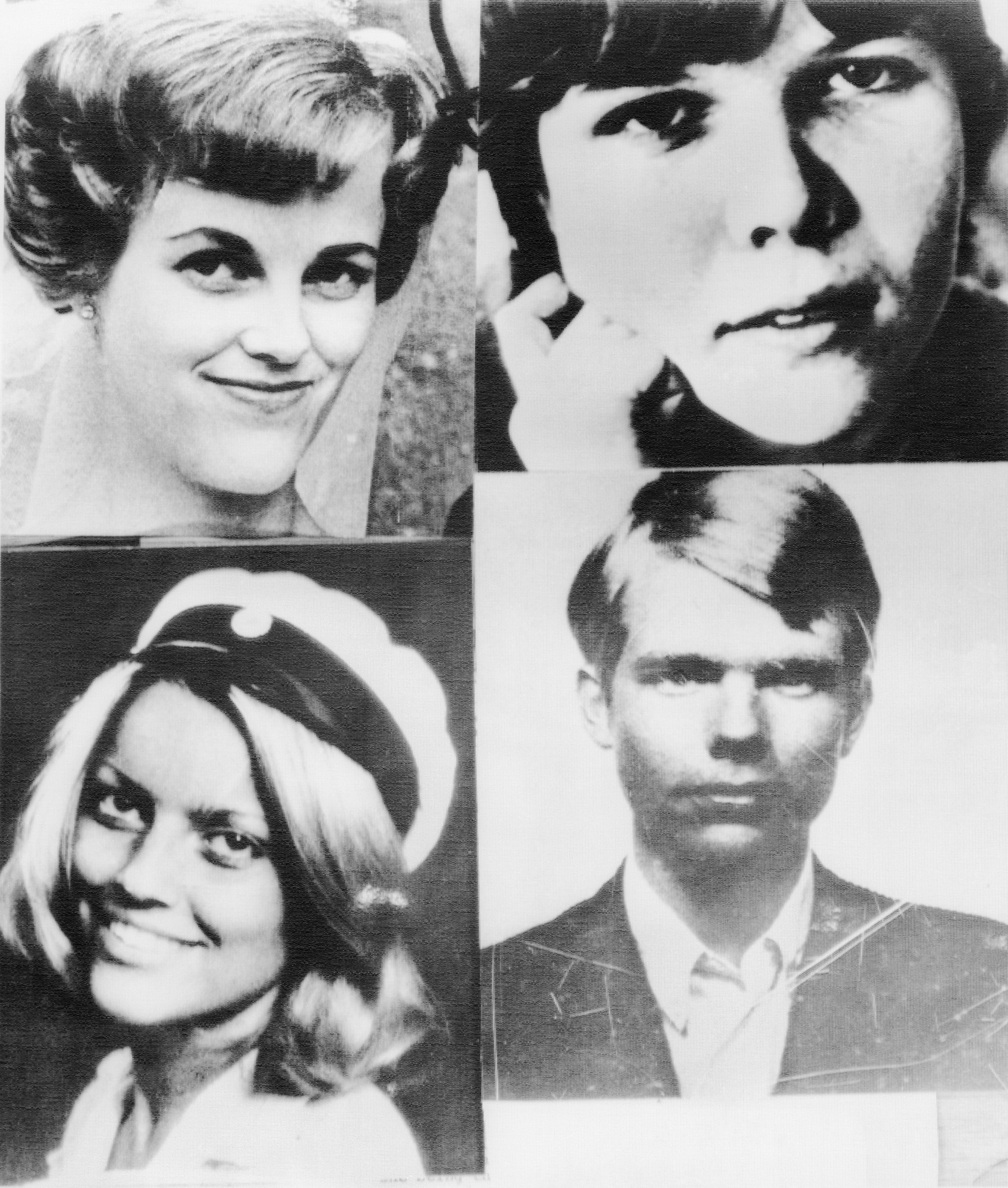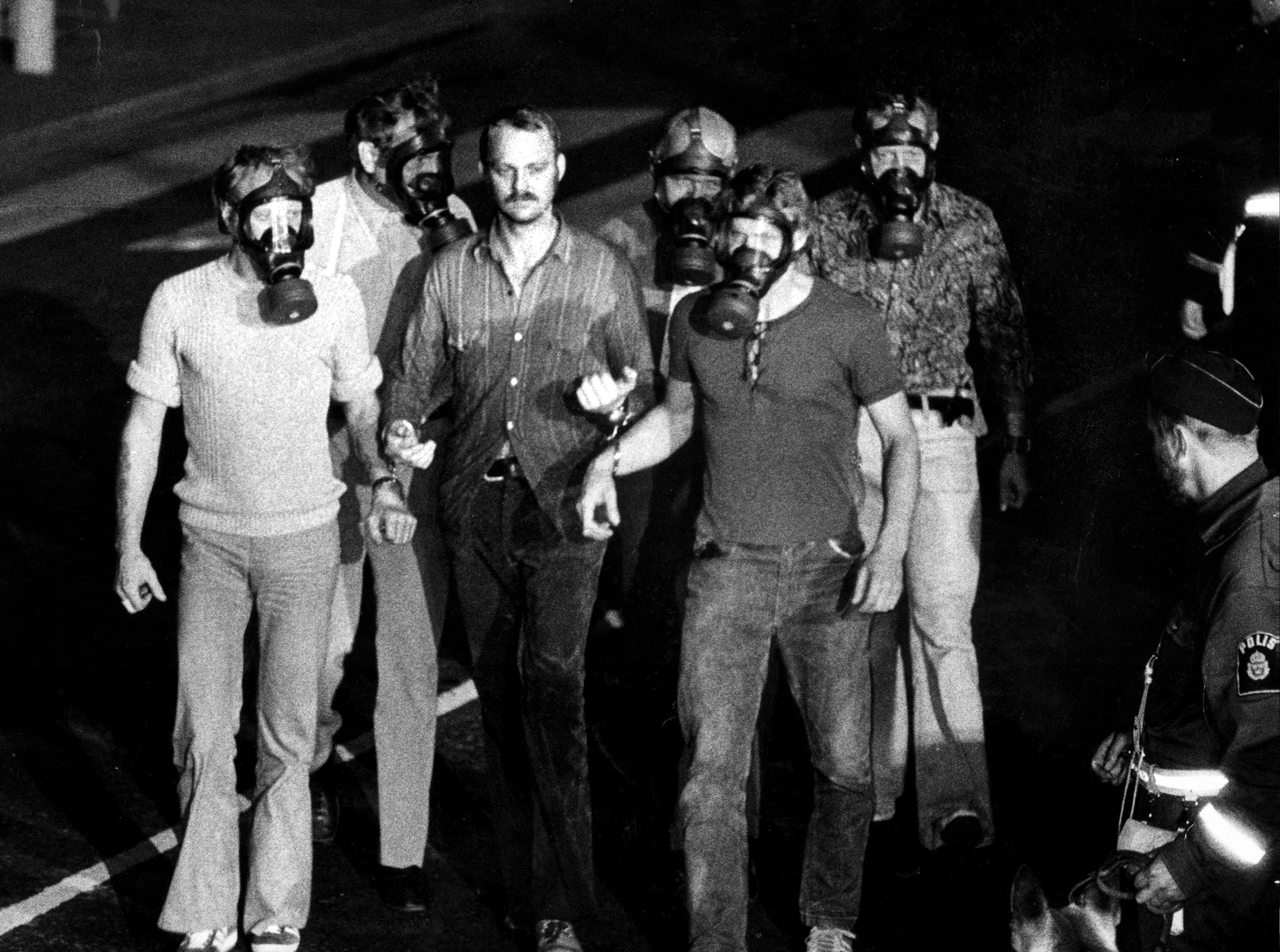Fifty years on, the bizarre bank heist that spawned ‘Stockholm syndrome’
In 1973, during a standoff with police that shocked and captivated Sweden, a surprising bond formed between bank robber Jan-Erik Olsson and his hostages, writes Donald Beaulieu

An escaped Swedish convict, disguised with a woman’s curly wig, blue-tinted sunglasses, a dyed-black moustache and rouged cheeks, walked into a Stockholm bank shortly after it opened on 23 August 1973, fired a submachine gun into the ceiling and yelled, in English with an American accent: “The party begins!”
Then things got weird. When that convict, Jan-Erik Olsson, first walked into the bank that Thursday, the employees who would become his hostages felt nothing but fear. “I believed a maniac had come into my life,” then-23-year-old bank clerk Kristin Enmark later told The New Yorker. “I believed I was seeing something that could only happen in America.”
But the hostages’ terror didn’t last. In fact, over the course of the ensuing six-day standoff, which shocked and enthralled the Swedish public and dumbfounded the police, a surprising bond formed between the robber and his four captives. It spawned, in the end, a new psychological term: Stockholm syndrome.
Day 1: Into the vault
Sweden had never experienced anything like the drama that unfolded 50 years ago at the Sveriges Kreditbank, in Stockholm’s upscale Norrmalmstorg square.
Crime was low in the country, known for its peace, prosperity and liberal social welfare. But there were criminals. Olsson had been serving a three-year sentence for grand larceny, until the prison released him on temporary furlough early that August for good behaviour. He simply never returned, and he began planning a very unorthodox robbery.
The disguised Olsson decided against making off with the bank’s money, instead taking its young employees hostage and making demands of the police when they arrived. He wanted 3 million Swedish kronor (about £562,000 at the time) and a fast getaway car. Plus, to assist with his plan, he wanted the police to deliver him an accomplice: his former prison-block neighbour Clark Olofsson, a serial bank robber whose string of creative prison escapes had made him a virtual celebrity in Sweden.
Olsson wagered that there was no chance “the government would risk killing the women if he did not get his way,” David King wrote in Six Days in August: The Story of Stockholm Syndrome. “Not in Sweden. Certainly not this year, when the prime minister faced a close election.”

So, with sharpshooters swarming around the building, Olsson retreated inside the bank vault with his hostages, leaving the door only slightly ajar, and waited for his demands to be met. Enmark’s hands and feet had been tied, along with those of her colleagues: bank teller Elisabeth Oldgren, 21, and Birgitta Lundblad, 31 and the only hostage who was married with children.
Initially, the gamble paid off. The money, the car – a blue Ford Mustang – and Olofsson himself all arrived at Kreditbank by the end of the day. According to King, Olsson envisioned driving off with the bags of money, Olofsson and a few hostages, then escaping Sweden by boat.
But while police technically fulfilled his demands, they withheld the Mustang’s keys. Olsson and his growing group were stuck. Nervous and short-tempered, Olsson shouted orders that day and threatened to kill people who resisted. He already had shot one police officer in the hand. But the great prison escapee Olofsson’s arrival in the afternoon brought those inside some welcome calm.
“When I came, they were terrified,” Olofsson said in 2019 on the podcast Criminal. “After five minutes, they were cool. I said, ‘Hey, take it easy, we’re going to fix this.’” He untied the three women and, walking around the bank for surveillance, found another employee, Sven Safstrom, 24, hiding in a stock room. Safstrom became the fourth hostage.
Olofsson brought in one of the bank’s phones and connected it inside the vault so that the hostages could call their families. When Lundblad could not reach her husband and children, she began to cry. Olsson, her captor, touched her cheek, according to The New Yorker, and said softly: “Try again, don’t give up.”
Day 2: News crews and a near-shooting
On Friday, after the first night in the vault, Oldgren was feeling claustrophobic, so Olsson cut a long piece of rope, tied it around her neck and let her walk around the bank on a 30-foot leash. Later, he draped his jacket around her shoulders when she was shivering from the cold.
As the day progressed, Olsson grew frustrated over the stalemate with authorities. He persuaded Safstrom to allow Olsson to shoot him in the thigh in front of the police to prove he was serious. Olsson promised the shot would just graze him. “It’s only in the leg,” Enmark said as encouragement, according to Six Days in August.
Safstrom waited for a signal to get in position, but Olsson didn’t follow through. “I still don’t know why the signal never came,” Safstrom told The New Yorker. “All that comes back to me is how kind I thought he was for saying it was my just my leg he would shoot.”

Meanwhile, onlookers crowded Norrmalmstorg square outside, and news crews covered the events relentlessly, interviewing the hostages and their captors by phone all day Friday. The Swedish newspaper Aftonbladet dubbed it “the pornography of violence.”
Around 5pm, Enmark talked to Olof Palme, the Swedish prime minister, and radio and TV stations broadcast clips of their conversation. She asked Palme to allow Olsson to leave the bank and drive off with the money, and she volunteered to go along as his captive.
“I fully trust Clark and the robber. I am not desperate. They haven’t done a thing to us,” Enmark said. “On the contrary, they have been very nice. But you know, Olof, what I am scared of is that the police will attack and cause us to die.”
Palme refused, claiming that it would endanger the public “to let people out on the roads with weapons and innocent people.” The police, with no precedent to guide their response, were already overwhelmed.
Olsson’s disguise, it turned out, had succeeded: the police had no idea who he was, and they ended up misidentifying him as another prison escapee Olofsson had known, Kaj Hansson. They even brought in Hansson’s teenage brother, Dan, to reason with the robber, only to be met with gunfire. Later, the police had Dan call the vault phone, according to King.
Dan hung up after talking to Olsson and called the policemen “idiots”. “You have the wrong guy!” he yelled.
Day 3: A ‘bond of friendship’ formed
On Saturday morning, after the second night in the Kreditbank branch, the police tried a risky solution. An officer snuck in and closed the door of the vault, locking the hostages inside with Olsson and Olofsson. For those in the vault, the open door had been their lifeline, through which the police had delivered food and drink to sustain them and through which Olsson had maintained slim hope of escaping. That hope was now gone.

Phone contact inside the vault also was cut off to anyone but the police, who feared the media’s unlimited access would deliver Olsson a cult status. With the robber finally contained, the police also hoped everyone inside would form what Nils Bejerot, a psychiatrist they consulted, described as a “bond of friendship” that would prevent Olsson from inflicting harm on his hostages.
Such connections, in fact, had already begun to form – and police didn’t foresee how strong they’d become.
That afternoon, not knowing when they would eat next, Olsson pulled out three pears left over from a previous meal, cut each in half and gave everyone a portion. All noticed Olsson taking the smallest piece, King reported. “When he treated us well,” Safstrom said, according to The New Yorker, “we could think of him as an emergency god.”
As she fell asleep that night, Enmark could hear everyone’s breathing and tell when they were in sync. She even tried to change her breathing to match. “That was our world,” she said. “We were in the vault in order to breathe, to survive. Whoever threatened that world was our enemy.”
Days 4 and 5: Not just a drill
On Sunday, drilling disrupted the group’s calm.
A crew had started working to punch through the vault from above – ostensibly, the police told Olsson, to create a hole wide enough for him to surrender his weapon. It took hours to drill through the steel-and-concrete ceiling, and those in the vault deduced the real reason for it: to pump in tear gas and force the robber to surrender.
In response, Olsson positioned the hostages under the hole with nooses around their necks, the ropes attached to the top of a row of safe-deposit boxes. He told police that if any gas knocked the captives unconscious, the nooses – and, by extension, the police – would end up killing them.
“I didn’t think he was going to hang us,” Enmark said in 2016, on the podcast Memory Motel. But the hostages worried what the gas would do to them. Olsson had shared his theory about tear gas: after 15 minutes of exposure, he told them, they all would suffer permanent brain damage.
To circumvent the makeshift gallows, workers started drilling more holes above other parts of the vault. The police sent a bucket containing sandwiches down the original hole, the hostages’ first real meal in days, giving them a brief respite from standing in their nooses. As they began to tire, Olsson let them rotate in shifts, and Safstrom asked the robber whether he could do the standing for all of them.
“He was a real man,” Olsson told The New Yorker. “He was ready to be a hostage for the hostages.”
Day 6: Syndrome or survival tactic?
By Tuesday, the crew had drilled seven holes into the ceiling, and shortly after the last one was completed, gas began pouring into the vault. The hostages were on their hands and knees, coughing and choking, before Olsson could order them back to the nooses. Soon the police heard voices yelling: “We give up!”

After opening the door, the police ordered the hostages out first, but they refused, fearful that Olsson and Olofsson would be killed by the police if left alone in the vault. Enmark and Oldgren hugged and kissed Olsson, Safstrom shook his hand, and Lundblad asked him to write to her. Then the robber walked with his accomplice out of the bank vault and into police custody.
Bejerot, the consulting psychiatrist, is credited with coining Stockholm syndrome that year to describe the phenomenon of captives developing emotional bonds with their captors. Professional associations have not accepted it as a psychological diagnosis, though it has been invoked since in some cases of abuse, for prisoners of war and, notably, in the kidnapping of Patty Hearst, the year after Olsson’s Stockholm robbery.
But Enmark, who left the bank and became a psychotherapist, said in 2016 that the hostages’ relationship with Olsson was more self-preservation than syndrome.
“I think it is a way of blaming the victim,” she said. “All the things I did was instinct of survival. I wanted to survive. I don’t think it’s so odd. What would you do?”
© The Washington Post




Join our commenting forum
Join thought-provoking conversations, follow other Independent readers and see their replies
Comments